

Compact Muon Solenoid
LHC, CERN
| CMS-PAS-FTR-18-019 | ||
| Prospects for HH measurements at the HL-LHC | ||
| CMS Collaboration | ||
| December 2018 | ||
| Abstract: The prospects for the study of Higgs boson pair production at the High-Luminosity LHC with the CMS detector are presented. Five decay channels, bbbb, bbWW, bbττ, bbγγ, and bbZZ, are studied. Analyses are developed using a parametric simulation of the upgraded detector response and optimised for a projected integrated luminosity of 3000 fb−1. The statistical combination of the five decay channels results in an expected significance for the standard model HH signal of 2.6σ. Projections are also presented for the measurement of the Higgs boson self-coupling λHHH. The expected 68 and 95% confidence level intervals for the coupling modifier κλ=λHHH/λSMHHH are [0.35,1.9] and [−0.18,3.6], respectively. | ||
| Links: CDS record (PDF) ; inSPIRE record ; CADI line (restricted) ; | ||
| Figures | |
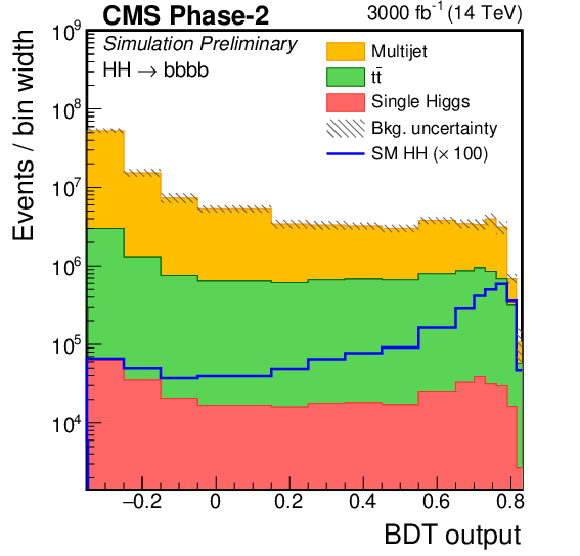
png pdf |
Figure 1:
BDT output distribution for the signal and background processes considered in the bbbb resolved search. |
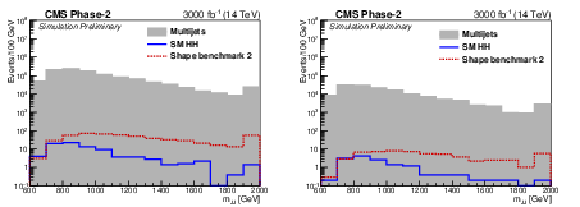
png pdf |
Figure 2:
mJJ distributions for the estimated multijet background and the SM (blue) and shape benchmark 2 (red) signals. The distributions on the left are for the 3b and those on the right are for the 4b subjet b-tagged categories. Both signals are normalised to the SM HH production cross section for visualisation. |
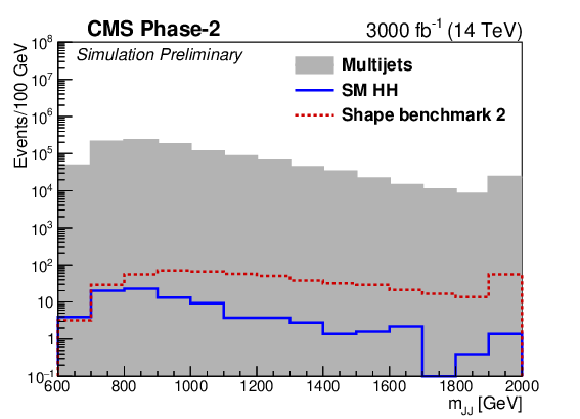
png pdf |
Figure 2-a:
mJJ distribution for the estimated multijet background and the SM (blue) and shape benchmark 2 (red) signals, in the 3b subjet b-tagged category. Both signals are normalised to the SM HH production cross section for visualisation. |
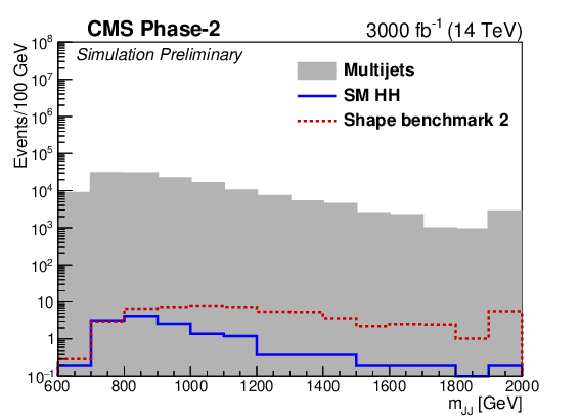
png pdf |
Figure 2-b:
mJJ distribution for the estimated multijet background and the SM (blue) and shape benchmark 2 (red) signals, in the 4b subjet b-tagged category. Both signals are normalised to the SM HH production cross section for visualisation. |
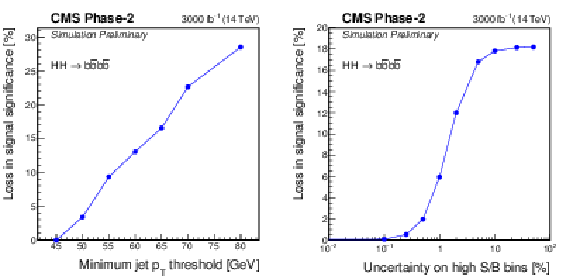
png pdf |
Figure 3:
Loss of sensitivity of the HH→bbbb resolved search as a function of the minimal jet pT threshold (left) and as a function of the uncertainty assumed on high S/B bins for the QCD multijet background (right). In each curve, only the quantity shown on the horizontal axis is varied while the other are kept fixed to the nominal values assumed. The "loss'' quantity plotted on the ordinate is defined 1−Z/Z0, where Z denotes the significance of the HH signal in the hypothesis considered and Z0 the significance for the cases of a 45 GeV pT threshold (left) and of no uncertainty considered (right). |
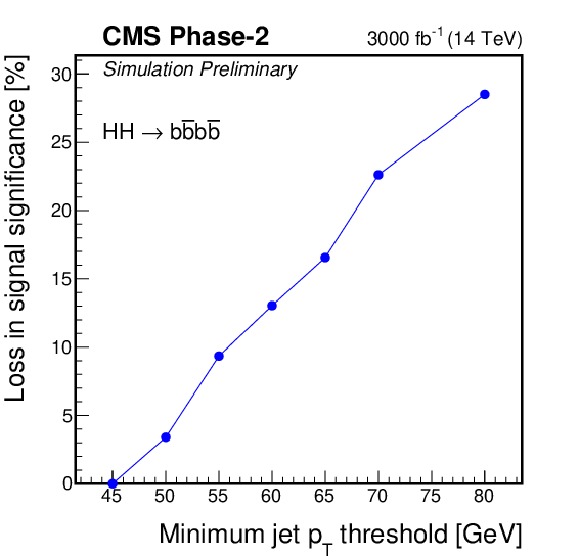
png pdf |
Figure 3-a:
Loss of sensitivity of the HH→bbbb resolved search as a function of the minimal jet pT threshold. Only the quantity shown on the horizontal axis is varied while the others are kept fixed to the nominal values assumed. The "loss'' quantity plotted on the ordinate is defined 1−Z/Z0, where Z denotes the significance of the HH signal in the hypothesis considered and Z0 the significance for the case of a 45 GeV pT threshold. |
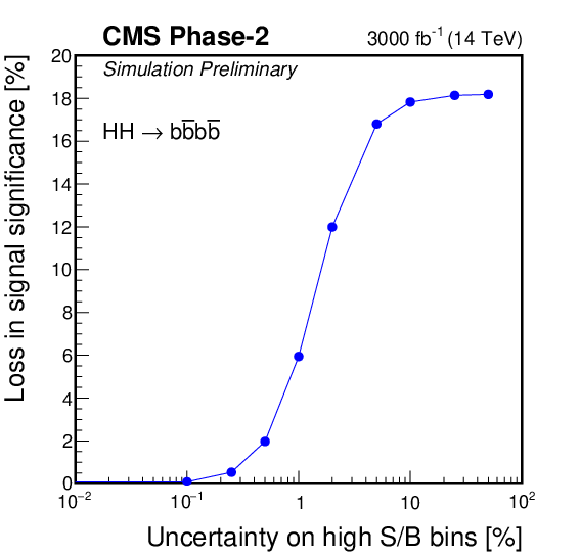
png pdf |
Figure 3-b:
Loss of sensitivity of the HH→bbbb resolved search as a function of the uncertainty assumed on high S/B bins for the QCD multijet background (right). Only the quantity shown on the horizontal axis is varied while the others are kept fixed to the nominal values assumed. The "loss'' quantity plotted on the ordinate is defined 1−Z/Z0, where Z denotes the significance of the HH signal in the hypothesis considered and Z0 the significance for the case of no uncertainty considered. |
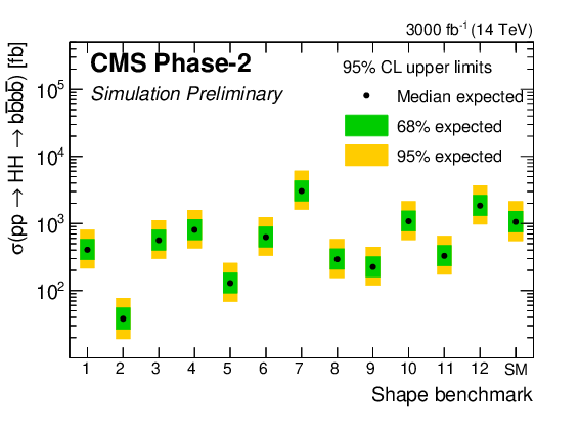
png pdf |
Figure 4:
The expected upper limits for non-resonant HH production in the standard model and other shape benchmarks (1-12). The inner (green) and the outer (yellow) bands indicate the regions containing the 68 and 95%, respectively, of the distribution of limits expected under the background-only hypothesis. |
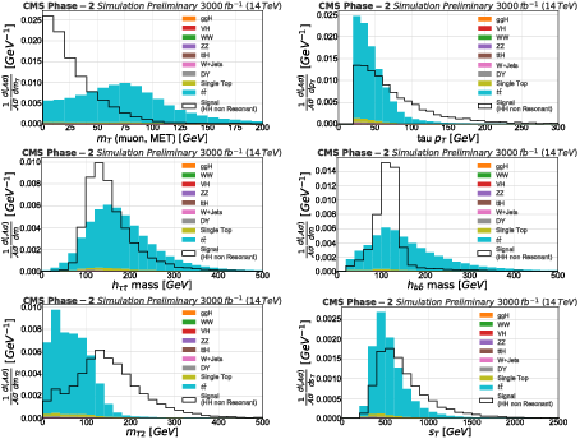
png pdf |
Figure 5:
Example distributions for some of the features of the signal and background processes. Low-level features in the μτh final-state: (a) Transverse mass of the muon (i.e. τμ), as defined in xxxxx, (b) Transverse momentum of the τh. Higgs-candidate masses for all final states together: (c) Hττ mass, (d) Hb¯b mass. High-level features for all final-states channels together: (e) The stransverse mass MT2, (f) sT (defined as the scalar sum of lepton pT, pT of both b-jets and τh, and pTmiss). Distributions are normalized to unit areas for signal and background, separately. |
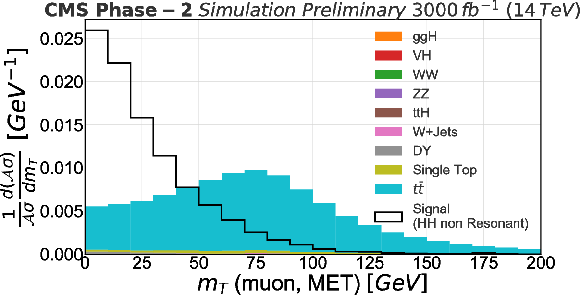
png pdf |
Figure 5-a:
Distribution of the transverse mass of the muon (i.e. τμ), as defined in 2, normalized to unit area for signal and background, separately. |
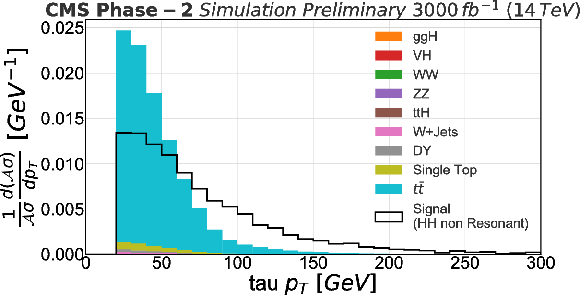
png pdf |
Figure 5-b:
Distribution of the transverse momentum of the τh, normalized to unit area for signal and background, separately. |
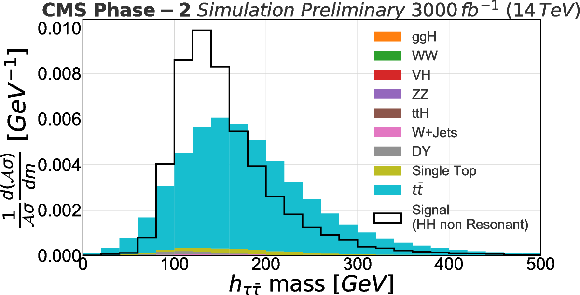
png pdf |
Figure 5-c:
Distribution of the Hττ mass, normalized to unit area for signal and background, separately. |
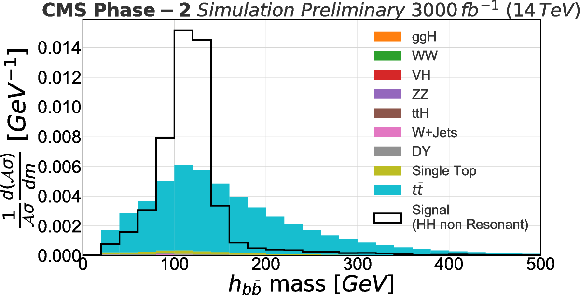
png pdf |
Figure 5-d:
Distribution of the Hb¯b mass, normalized to unit area for signal and background, separately. |
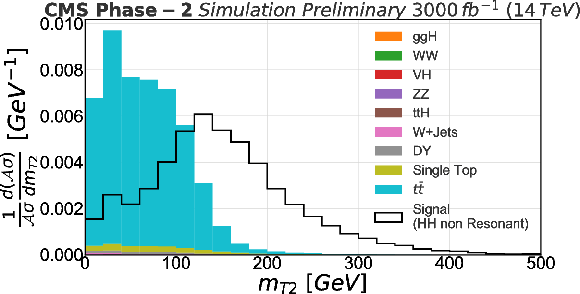
png pdf |
Figure 5-e:
Distribution of the stransverse mass MT2, normalized to unit area for signal and background, separately. |
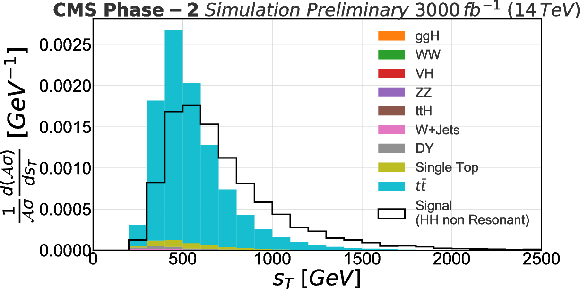
png pdf |
Figure 5-f:
Distribution of sT (defined as the scalar sum of lepton pT, pT of both b-jets and τh, and pTmiss), normalized to unit area for signal and background, separately. |
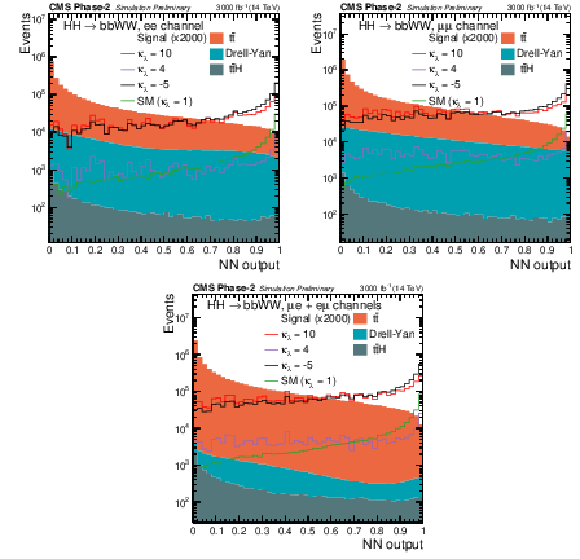
png pdf |
Figure 6:
The output of the NN after the selections, evaluated in the e+e− (top left), μ+μ− (top right), e±μ∓ (bottom) channels. |
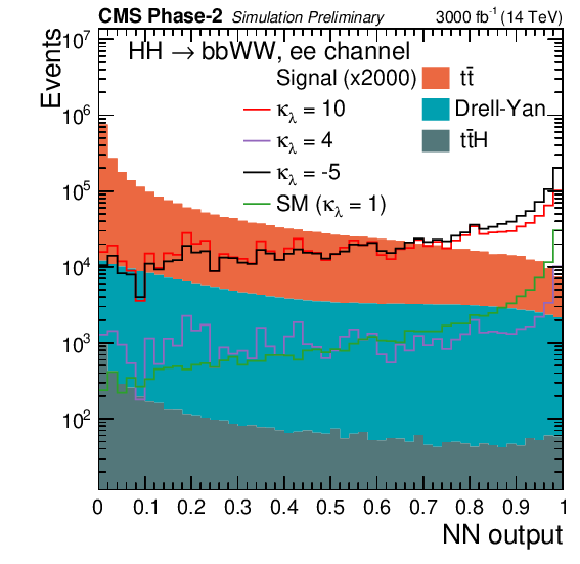
png pdf |
Figure 6-a:
The output of the NN after the selections, evaluated in the e+e− channel. |
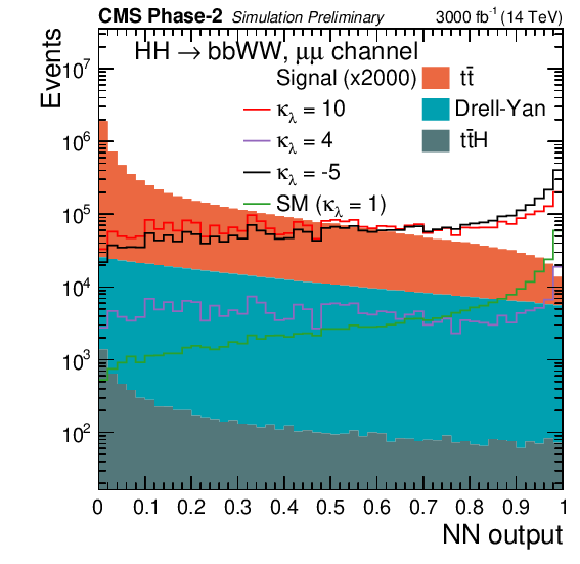
png pdf |
Figure 6-b:
The output of the NN after the selections, evaluated in the μ+μ− channel. |
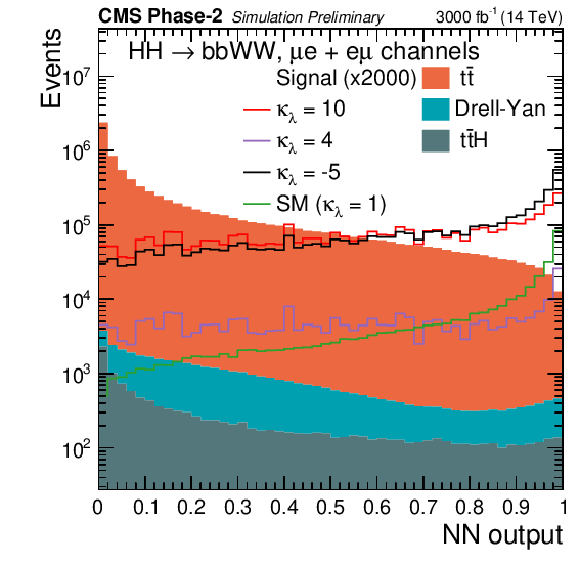
png pdf |
Figure 6-c:
The output of the NN after the selections, evaluated in the e±μ∓ channel. |
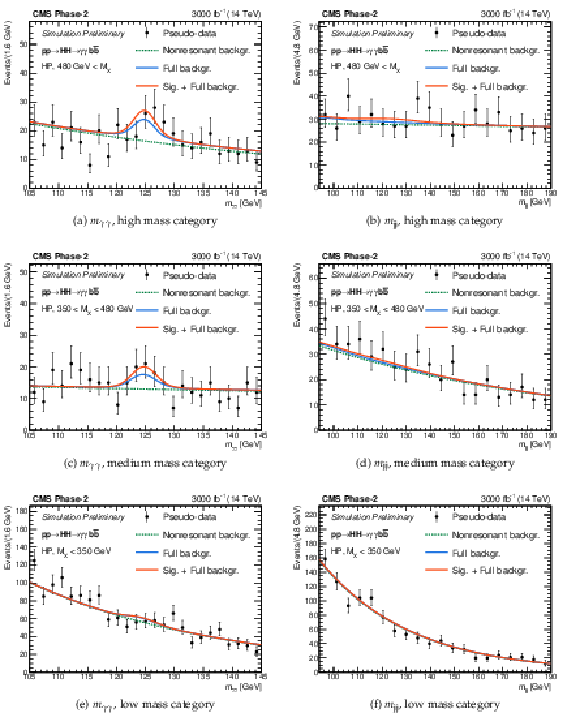
png pdf |
Figure 7:
Expected distribution of events in the photon (left column) and jet (right column) pair invariant mass. The full circles denote pseudo-data obtained from the expected events yields for the sum of the signal and background processes for 3000 fb−1. Only the most sensitive high purity category is shown. |
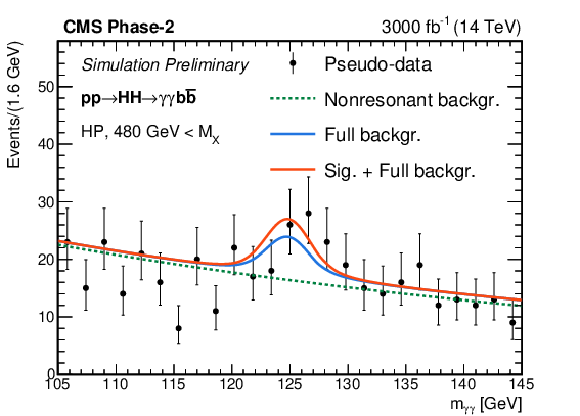
png pdf |
Figure 7-a:
Expected distribution of events in the photon pair invariant mass, in the high mass category. The full circles denote pseudo-data obtained from the expected events yields for the sum of the signal and background processes for 3000 fb−1. Only the most sensitive high purity category is shown. |
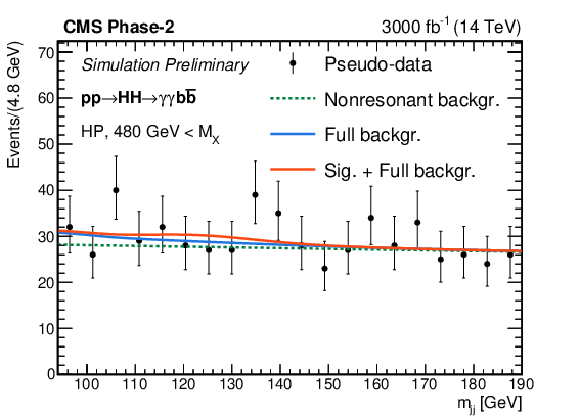
png pdf |
Figure 7-b:
Expected distribution of events in the jet pair invariant mass, in the high mass category. The full circles denote pseudo-data obtained from the expected events yields for the sum of the signal and background processes for 3000 fb−1. Only the most sensitive high purity category is shown. |
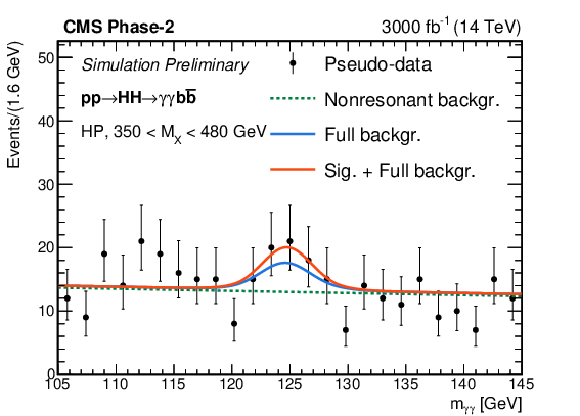
png pdf |
Figure 7-c:
Expected distribution of events in the photon pair invariant mass, in the medium mass category. The full circles denote pseudo-data obtained from the expected events yields for the sum of the signal and background processes for 3000 fb−1. Only the most sensitive high purity category is shown. |
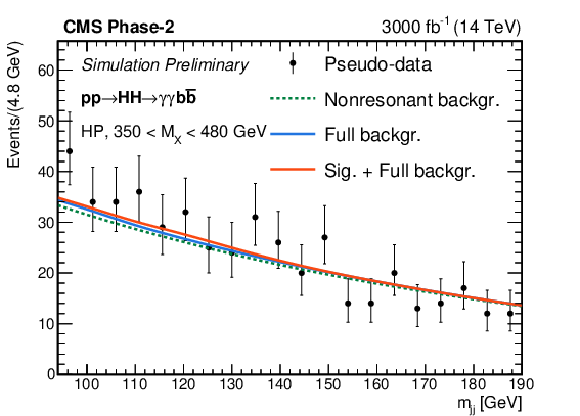
png pdf |
Figure 7-d:
Expected distribution of events in the jet pair invariant mass, in the medium mass category. The full circles denote pseudo-data obtained from the expected events yields for the sum of the signal and background processes for 3000 fb−1. Only the most sensitive high purity category is shown. |
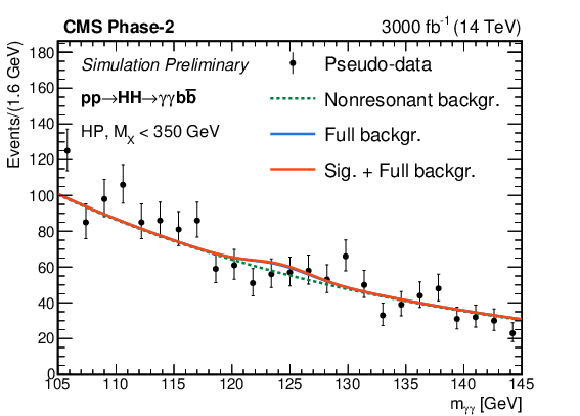
png pdf |
Figure 7-e:
Expected distribution of events in the photon pair invariant mass, in the low mass category. The full circles denote pseudo-data obtained from the expected events yields for the sum of the signal and background processes for 3000 fb−1. Only the most sensitive high purity category is shown. |
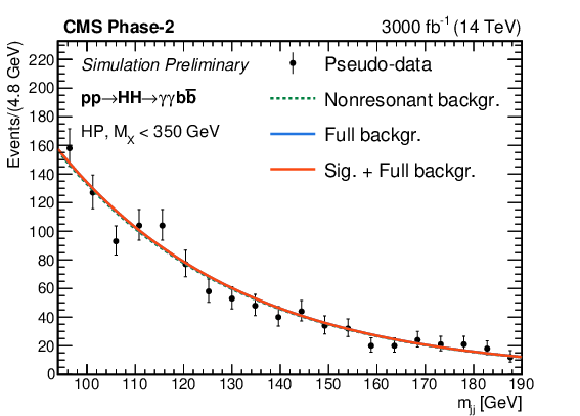
png pdf |
Figure 7-f:
Expected distribution of events in the jet pair invariant mass, in the low mass category. The full circles denote pseudo-data obtained from the expected events yields for the sum of the signal and background processes for 3000 fb−1. Only the most sensitive high purity category is shown. |
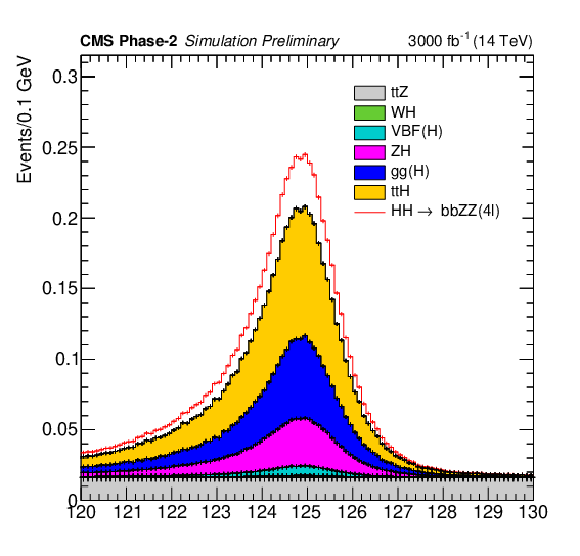
png pdf |
Figure 8:
Invariant mass distribution of the four leptons selected at the end of the analysis for the b¯b4ℓ final state. |
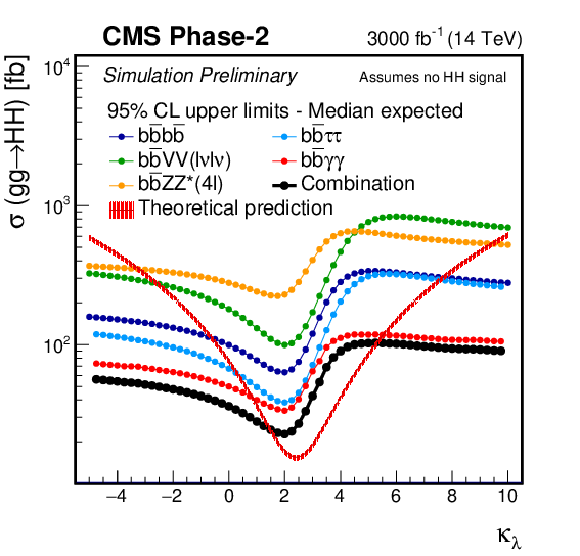
png pdf |
Figure 9:
Upper limit at the 95% CL on the HH production cross section as a function of κλ=λHHH/λHHHSM for the five decays channels investigated and their combination. The red band indicated the theoretical production cross section. |
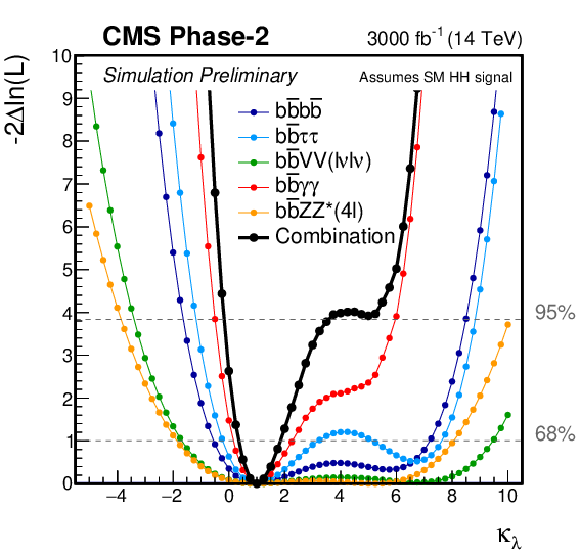
png pdf |
Figure 10:
Expected likelihood scan as a function of κλ=λHHH/λHHHSM. The functions are shown separately for the five decay channels studied and for their combination. |
| Tables | |
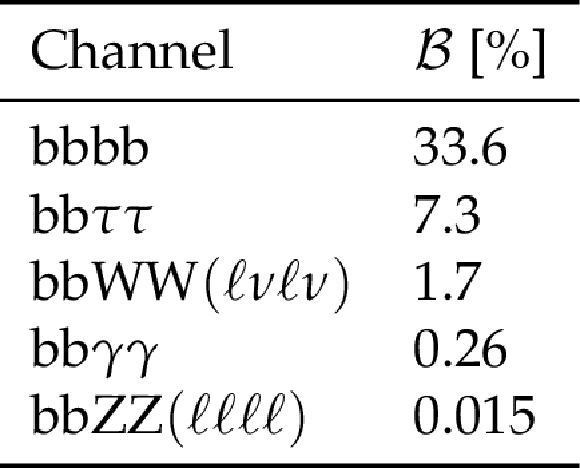
png pdf |
Table 1:
Branching fraction of the five decay channels considered in this document. The symbol ℓ denotes either a muon or an electron. In the bbWW decay channel, ℓ from the intermediate production of a τ lepton are also considered in the branching fraction. |
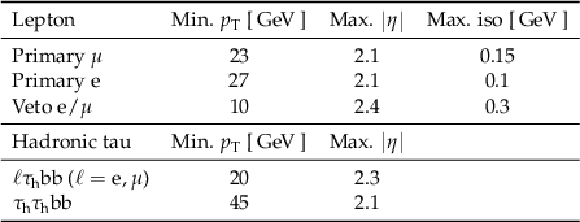
png pdf |
Table 2:
Kinematic requirements (pT, η, and isolation) of electrons, muons, and hadronic taus. The hadronic tau requirements are listed according to the final states considered. |
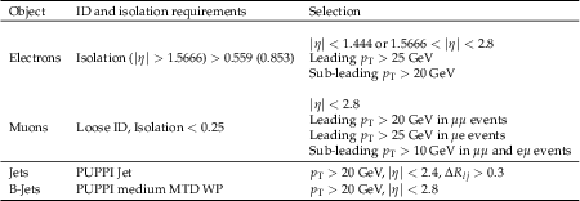
png pdf |
Table 3:
Object definitions and event selections requirements. |
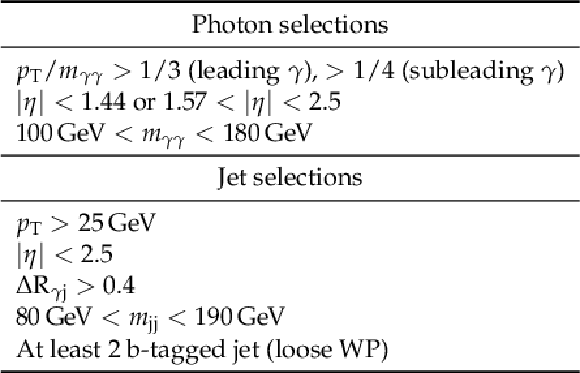
png pdf |
Table 4:
Photon and jet kinematic selections. |
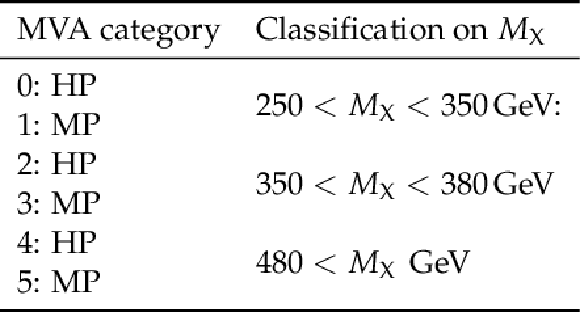
png pdf |
Table 5:
Categorisation applied for events selected in the bbγγ analysis. The symbols MP and HP denote, respectively, the medium and high purity categories based on the BDT output. |
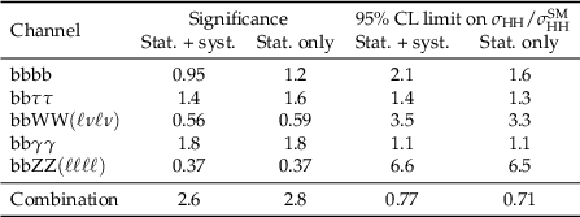
png pdf |
Table 6:
Upper limit at the 95% confidence level, significance, projected measurement at 68% confidence level of the Higgs boson self coupling λHHH for the five channels studied and their combination. Systematic and statistical uncertainties are considered. |
| Summary |
| Prospects for the search of Higgs boson pair (HH) production and for the measurement of the Higgs boson self-coupling (λHHH) at the High-Luminosity LHC (HL-LHC) are presented. The study is performed using the five decay channels of the HH system to bbbb, bbττ, bbWW (with both W decaying leptonically), bbγγ, and bbZZ (with both Z decaying to a pair of electrons or muons). The response of the upgraded CMS detector is studied with a parametric simulation that accounts for an average of 200 pp interactions per bunch crossing, and simulates the performance in the reconstruction and identification of physics objects. Assuming that no HH signal exists, a 95% confidence level (CL) upper limit on its cross section can be set to 0.77 times the SM prediction. Assuming that a HH signal exists with the properties predicted by the SM, we expect a combined significance of 2.6σ and a determination of the λHHH coupling corresponding to the interval [0.35,1.9] at the 68% CL and to [−0.18,3.6] at the 95% CL. |
| References | ||||
| 1 | ATLAS Collaboration | Observation of a new particle in the search for the Standard Model Higgs boson with the ATLAS detector at the LHC | PLB 716 (2012) 1 | 1207.7214 |
| 2 | CMS Collaboration | Observation of a new boson at a mass of 125 GeV with the CMS experiment at the LHC | PLB 716 (2012) 30 | CMS-HIG-12-028 1207.7235 |
| 3 | CMS Collaboration | Observation of a new boson with mass near 125 GeV in pp collisions at √s= 7 and 8 TeV | JHEP 06 (2013) 081 | CMS-HIG-12-036 1303.4571 |
| 4 | ATLAS and CMS Collaborations | Measurements of the Higgs boson production and decay rates and constraints on its couplings from a combined ATLAS and CMS analysis of the LHC pp collision data at √s= 7 and 8 TeV | JHEP 08 (2016) 045 | 1606.02266 |
| 5 | F. Englert and R. Brout | Broken symmetry and the mass of gauge vector mesons | PRL 13 (1964) 321 | |
| 6 | P. W. Higgs | Broken symmetries and the masses of gauge bosons | PRL 13 (1964) 508 | |
| 7 | G. S. Guralnik, C. R. Hagen, and T. W. B. Kibble | Global conservation laws and massless particles | PRL 13 (1964) 585 | |
| 8 | F. Goertz, A. Papaefstathiou, L. L. Yang, and J. Zurita | Higgs boson pair production in the D=6 extension of the SM | JHEP 04 (2015) 167 | 1410.3471 |
| 9 | M. Grazzini et al. | Higgs boson pair production at NNLO with top quark mass effects | JHEP 05 (2018) 059 | 1803.02463 |
| 10 | ATLAS Collaboration | Studies of the ATLAS potential for Higgs self-coupling measurements at a High Luminosity LHC | ATL-PHYS-PUB-2013-001, CERN, Geneva | |
| 11 | ATLAS Collaboration | Higgs Pair Production in the H(→ττ)H(→bˉb) channel at the High-Luminosity LHC | ATL-PHYS-PUB-2015-046, CERN, Geneva | |
| 12 | ATLAS Collaboration | Prospects for Observing tˉtHH Production with the ATLAS Experiment at the HL-LHC | ATL-PHYS-PUB-2016-023, CERN, Geneva | |
| 13 | ATLAS Collaboration | Study of the double Higgs production channel H(→bˉb)H(→γγ) with the ATLAS experiment at the HL-LHC | ATL-PHYS-PUB-2017-001, CERN, Geneva | |
| 14 | CMS Collaboration | Higgs pair production at the High Luminosity LHC | CMS-PAS-FTR-15-002 | CMS-PAS-FTR-15-002 |
| 15 | CMS Collaboration | Projected performance of Higgs analyses at the HL-LHC for ECFA 2016 | CMS-PAS-FTR-15-002 | CMS-PAS-FTR-15-002 |
| 16 | CMS Collaboration | The Phase-2 Upgrade of the CMS Tracker | CDS | |
| 17 | CMS Collaboration | The Phase-2 Upgrade of the CMS Barrel Calorimeters Technical Design Report | CDS | |
| 18 | CMS Collaboration | The Phase-2 Upgrade of the CMS Endcap Calorimeter | CDS | |
| 19 | D. de Florian et al. | Handbook of LHC Higgs cross sections: 4. Deciphering the nature of the Higgs sector | CERN-2017-002-M | 1610.07922 |
| 20 | CMS Collaboration | Technical Proposal for the Phase-II Upgrade of the CMS Detector | CMS-PAS-TDR-15-002 | CMS-PAS-TDR-15-002 |
| 21 | CMS Collaboration | Expected performance of the physics objects with the upgraded CMS detector at the HL-LHC | CDS | |
| 22 | DELPHES 3 Collaboration | DELPHES 3, A modular framework for fast simulation of a generic collider experiment | JHEP 02 (2014) 57 | 1307.6346 |
| 23 | J. Alwall et al. | The automated computation of tree-level and next-to-leading order differential cross sections, and their matching to parton shower simulations | JHEP 07 (2014) 079 | 1405.0301 |
| 24 | A. Carvalho et al. | On the reinterpretation of non-resonant searches for Higgs boson pairs | 1710.08261 | |
| 25 | A. Carvalho et al. | Higgs Pair Production: Choosing Benchmarks With Cluster Analysis | JHEP 04 (2016) 126 | 1507.02245 |
| 26 | P. Nason | A New method for combining NLO QCD with shower Monte Carlo algorithms | JHEP 11 (2004) 040 | hep-ph/0409146 |
| 27 | S. Frixione, P. Nason, and C. Oleari | Matching NLO QCD computations with Parton Shower simulations: the POWHEG method | JHEP 11 (2007) 070 | 0709.2092 |
| 28 | S. Alioli, P. Nason, C. Oleari, and E. Re | A general framework for implementing NLO calculations in shower Monte Carlo programs: the POWHEG BOX | JHEP 06 (2010) 043 | 1002.2581 |
| 29 | S. Frixione, P. Nason, and G. Ridolfi | A Positive-weight next-to-leading-order Monte Carlo for heavy flavour hadroproduction | JHEP 09 (2007) 126 | 0707.3088 |
| 30 | T. Sjostrand et al. | An Introduction to PYTHIA 8.2 | CPC 191 (2015) 159--177 | 1410.3012 |
| 31 | M. Czakon and A. Mitov | Top++: A Program for the Calculation of the Top-Pair Cross-Section at Hadron Colliders | CPC 185 (2014) 2930 | 1112.5675 |
| 32 | M. Aliev et al. | HATHOR: HAdronic Top and Heavy quarks crOss section calculatoR | CPC 182 (2011) 1034--1046 | 1007.1327 |
| 33 | P. Kant et al. | HatHor for single top-quark production: Updated predictions and uncertainty estimates for single top-quark production in hadronic collisions | CPC 191 (2015) 74--89 | 1406.4403 |
| 34 | S. Agostinelli et al. | Geant4-a simulation toolkit | Nuclear Instruments and Methods in Physics Research Section A: Accelerators, Spectrometers, Detectors and Associated Equipment 506 (2003), no. 3, 250 -- 303 | |
| 35 | M. Cacciari, G. P. Salam, and G. Soyez | The anti-kt jet clustering algorithm | JHEP 04 (2008) 063 | 0802.1189 |
| 36 | M. Cacciari, G. P. Salam, and G. Soyez | FastJet User Manual | EPJC72 (2012) 1896 | 1111.6097 |
| 37 | D. Bertolini, P. Harris, M. Low, and N. Tran | Pileup Per Particle Identification | JHEP 10 (2014) 059 | 1407.6013 |
| 38 | CMS Collaboration | Technical proposal for a MIP timing detector in the CMS experiment Phase~2 upgrade | CDS | |
| 39 | CMS Collaboration | Search for production of Higgs boson pairs in the four b quark final state using large-area jets in proton-proton collisions at √s= 13 TeV | CMS-B2G-17-019 1808.01473 |
|
| 40 | D. Bertolini, P. Harris, M. Low, and N. Tran | Pileup Per Particle Identification | JHEP 10 (2014) 059 | 1407.6013 |
| 41 | CMS Collaboration | Jet energy scale and resolution in the CMS experiment in pp collisions at 8 TeV | JINST 12 (2017) P02014 | CMS-JME-13-004 1607.03663 |
| 42 | CMS Collaboration | Jet energy scale and resolution performances with 13 TeV data | CDS | |
| 43 | M. Dasgupta, A. Fregoso, S. Marzani, and G. P. Salam | Towards an understanding of jet substructure | JHEP 09 (2013) 029 | 1307.0007 |
| 44 | A. J. Larkoski, S. Marzani, G. Soyez, and J. Thaler | Soft drop | JHEP 05 (2014) 146 | 1402.2657 |
| 45 | J. Thaler and K. Van Tilburg | Maximizing boosted top identification by minimizing N-subjettiness | JHEP 02 (2012) 093 | 1108.2701 |
| 46 | CMS Collaboration | Identification of heavy-flavour jets with the CMS detector in pp collisions at 13 TeV | JINST (2017) | CMS-BTV-16-002 1712.07158 |
| 47 | CMS Collaboration | Search for vector boson fusion production of a massive resonance decaying to a pair of Higgs bosons in the four b quark final state at the HL-LHC using the CMS Phase 2 detector | CMS-PAS-FTR-18-003 | CMS-PAS-FTR-18-003 |
| 48 | CMS Collaboration | Search for a massive resonance decaying to a pair of Higgs bosons in the four b quark final state in proton-proton collisions at √s= 13 TeV | PLB 781 (2018) 244 | 1710.04960 |
| 49 | M. M. Nojiri, Y. Shimizu, S. Okada, and K. Kawagoe | Inclusive transverse mass analysis for squark and gluino mass determination | JHEP 06 (2008) 035 | 0802.2412 |
| 50 | C. G. Lester and D. J. Summers | Measuring masses of semiinvisibly decaying particles pair produced at hadron colliders | PLB463 (1999) 99--103 | hep-ph/9906349 |
| 51 | G. Klambauer, T. Unterthiner, A. Mayr, and S. Hochreiter | Self-normalizing neural networks | CoRR abs/1706.02515 (2017) | 1706.02515 |
| 52 | F. Chollet et al. | |||
| 53 | M. Abadi et al. | TensorFlow: Large-scale machine learning on heterogeneous systems | 2015 Software available from tensorflow.org. \url http://tensorflow.org/ | |
| 54 | The AMVA4NewPhysics ITN | Classification and regression tools in higgs measurements | ITN Deliverable, Work Package 1 (2018). \urlhttps://userswww.pd.infn.it/ dorigo/d1.4.pdf | |
| 55 | G. Cowan | Discovery sensitivity for a counting experiment with background uncertainty | \urlhttp://www.pp.rhul.ac.uk/ cowan/stat/medsig/medsigNote.pdf\\ and also talk slides \urlhttp://www.pp.rhul.ac.uk/ cowan/atlas/cowan_statforum_8may12.pdf | |
| 56 | A. Hoecker et al. | TMVA: Toolkit for Multivariate Data Analysis | PoS ACAT (2007) 040 | physics/0703039 |
| 57 | CMS Collaboration | Combination of searches for Higgs boson pair production in proton-proton collisions at √s= 13 TeV | CMS-HIG-17-030 1811.09689 |
|

|
Compact Muon Solenoid LHC, CERN |

|

|

|

|

|

|